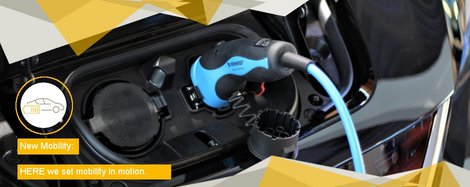Anhalt’s Hydrogen Train Is on the Right Track

The innovative railroad technology alliance TRAINS is tackling climate change on the railroads in Saxony-Anhalt
The flagship for the future railroad technology region of Anhalt is a train. Or to be exact, a “green” railcar that the Dessauer Verkehrs AG (Dessau’s local transport company) plans to test on the route between Dessau and Wörlitz. This technological innovation will be the first hydrogen train powered by a hydrogen-burning gas engine. The central project being carried out by the railroad technology cluster TRAINS is the retrofitting of existing multiple units with clean gas engines. The alliance is working hard to advance the fight against climate change in the rail industry while also transforming the region of Anhalt, which has a long history of railroad engineering, into a region of cutting-edge technology, creating jobs and promoting environmentally sound and user-friendly mobility in rural areas.
Chosen from 107 applicants
TRAINS was founded more than three years ago with the aim of further developing the Anhalt region. Its founders were the Verein Bahntechnologie Dessau e.V. (Dessau Railroad Technology Association), which numerous railroad engineering companies and institutions in the Anhalt region are part of, and Anhalt University of Applied Sciences. The alliance now boasts more than 50 members, including companies, research institutes, structural planners, the Chamber of Industry and Commerce, regional associations and politicians. Just over a year ago, TRAINS was awarded 12.2 million euros of funding by the funding program Wandel durch Innovation in der Region – WIR! (Transformation Through Innovation in the Region) run by the Federal Ministry of Education and Research. The new, green mobility project based in Saxony-Anhalt came out on top alongside just 20 other projects out of 107 applications from across Germany.
Practical implementation has now begun. The first project, “Studies on Diesel Replacement Solutions for Existing Operational Trains,” began a few days ago. For the next year, engineers and scientists will be developing practical technical solutions for retrofitting diesel engines so that they are suitable for hydrogen combustion. “Until now, there has been no such solution available; previous experiments have been carried out only on truck engines. TRAINS wants to prove that it is economically viable for rail operators to retrofit their fleets with gas engines, helping to get green mobility onto the tracks,” says Sascha Ziesemeier, the TRAINS Alliance Manager from Anhalt University of Applied Sciences, the largest university for applied sciences in Saxony-Anhalt. Ziesemeier also explained that the aim is of course for this retrofitting work to take place in the Anhalt region. The alliance includes partners that already have the necessary theoretical and practical expertise for installing gas combustion engines in existing operational trains as part of the energy revolution. They are WTZ Roßlau and the Institute of Mobile Systems at the Otto von Guericke University Magdeburg. KEYOU GmbH is also supporting the conversion of diesel engines to hydrogen combustion engines in Unterschleißheim, just outside of Munich.
The green power of hydrogen
However, the Saxony-Anhalt train will only be a green railcar if it is powered by green hydrogen. The plan is to produce the hydrogen via electrolysis using wind and photovoltaic energy produced by a power-to-gas system. By using green hydrogen as fuel, TRAINS will succeed in integrating the renewable energy sector with the railroad sector. The regional alliance also includes partners that specialize in the production of hydrogen via electrolysis.
The TRAINS alliance reinforces Anhalt’s expertise in railroad technology. The region’s history of railroad engineering goes back more than 100 years. Toward the end of the GDR, there were some 10,000 people employed in the industry in this area. Following a substantial dip in the 1990s, there are now around 2,500 employees in the industry, working predominately for medium-sized firms and their suppliers. Anhalt is the region surrounding Dessau-Roßlau, Anhalt-Bitterfeld and Wittenberg and has a population of some 390,000; it is one of Germany’s oldest industrial regions. The region continues to be shaped by the chemical, pharmaceutical and aviation industries as well as by mechanical and plant engineering, and by railroad engineering in particular.
“The TRAINS alliance, which is running around 20 sub-projects, is still in its infancy. With the capital provided by the industry companies involved, for example, around 16 million euros will have been invested by 2025,” says Alliance Manager Sascha Ziesemeier. As part of a further sub-project, scientists at Anhalt University of Applied Sciences are working on a digital project in which the green railcar is fitted with sensor technology so that it can predict possible damage with the help of a digital twin. In addition to the “Studies on Diesel Replacement Solutions,” the construction of the TRAINS Center is also underway. This innovation and service center for railroad technology is where the different parties involved will implement technological developments with the hope of including national research partners, too. It is expected that all of the innovative railroad mobility projects in Saxony-Anhalt will have been implemented by the end of 2025.
Author: Michael Falgowski/IMG Saxony-Anhalt
Contact:
Sascha Ziesemeier, M.Sc. TRAINS Alliance Manager
Anhalt University of Applied Sciences
Research and Technology Transfer Center (FTTZ)
Tel.: +49 (0) 3496/67-5321
Fax: +49 (0) 3496/67-95321
Mobile: +49 (0) 177/8233481
Email: sascha.ziesemeier.ignore@hs-anhalt.de
Web: https://www.innovation-strukturwandel.de/de/2279.php
HERE we set mobility in motion.

The mobility of tomorrow is being conceived and tested in Saxony-Anhalt. HERE, components, systems and technologies are being developed as advance development for the automobiles that the OEMs will create tomorrow. And HERE procedures are optimised for new, manageable, and rapidly implementable technologies.
> Further information about New Mobility in Saxony-Anhalt HERE.
